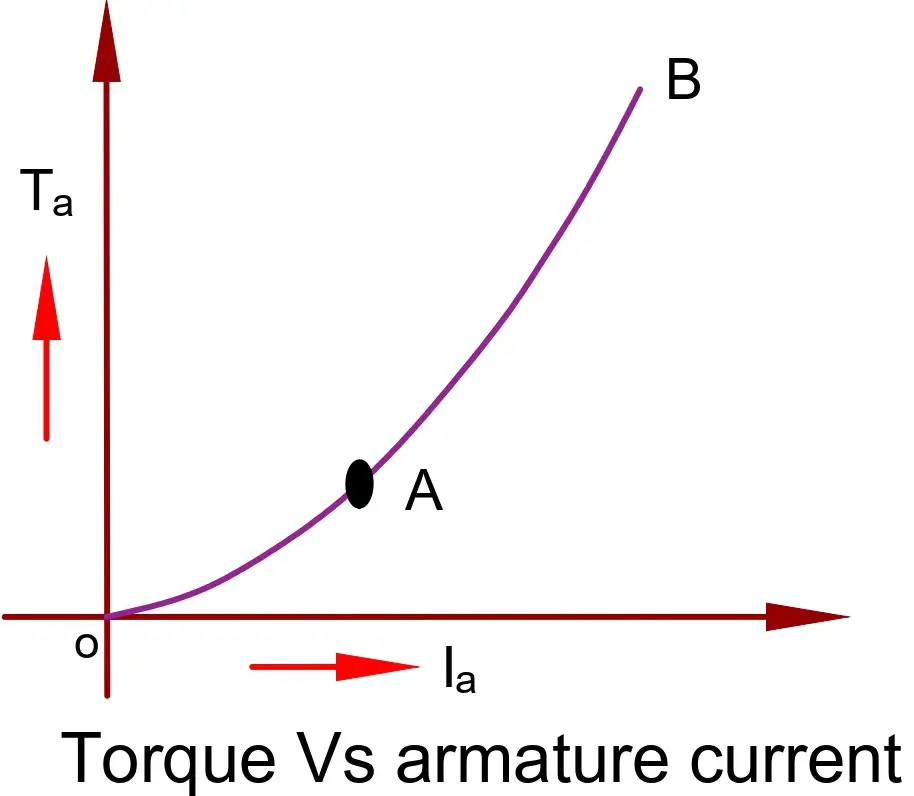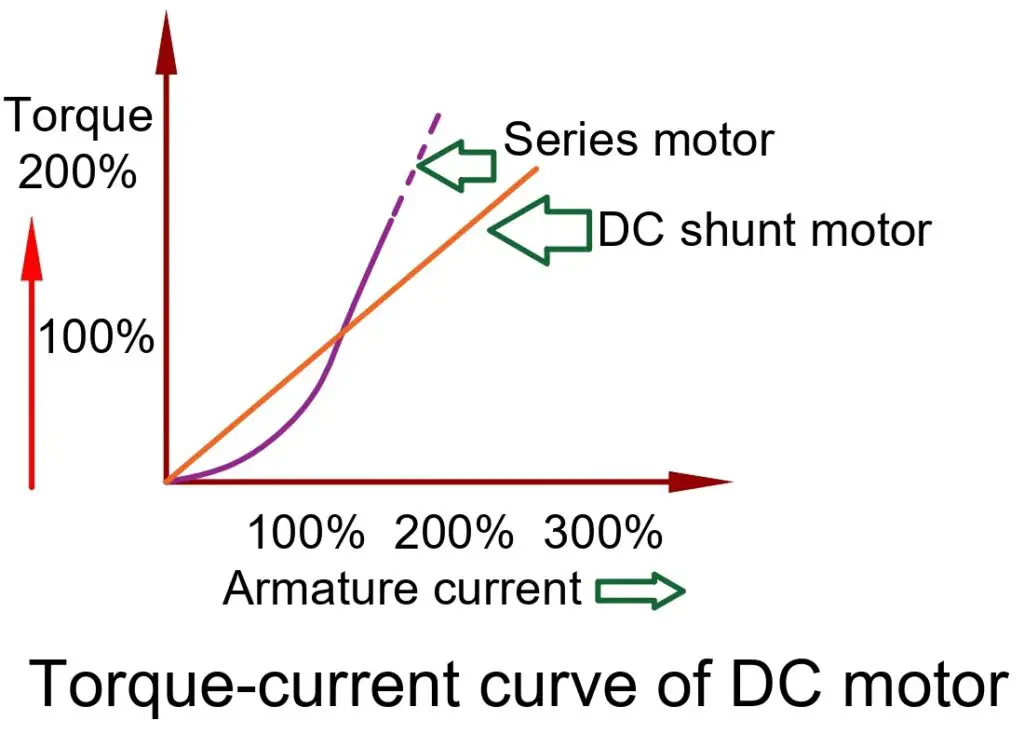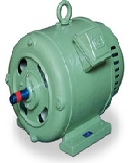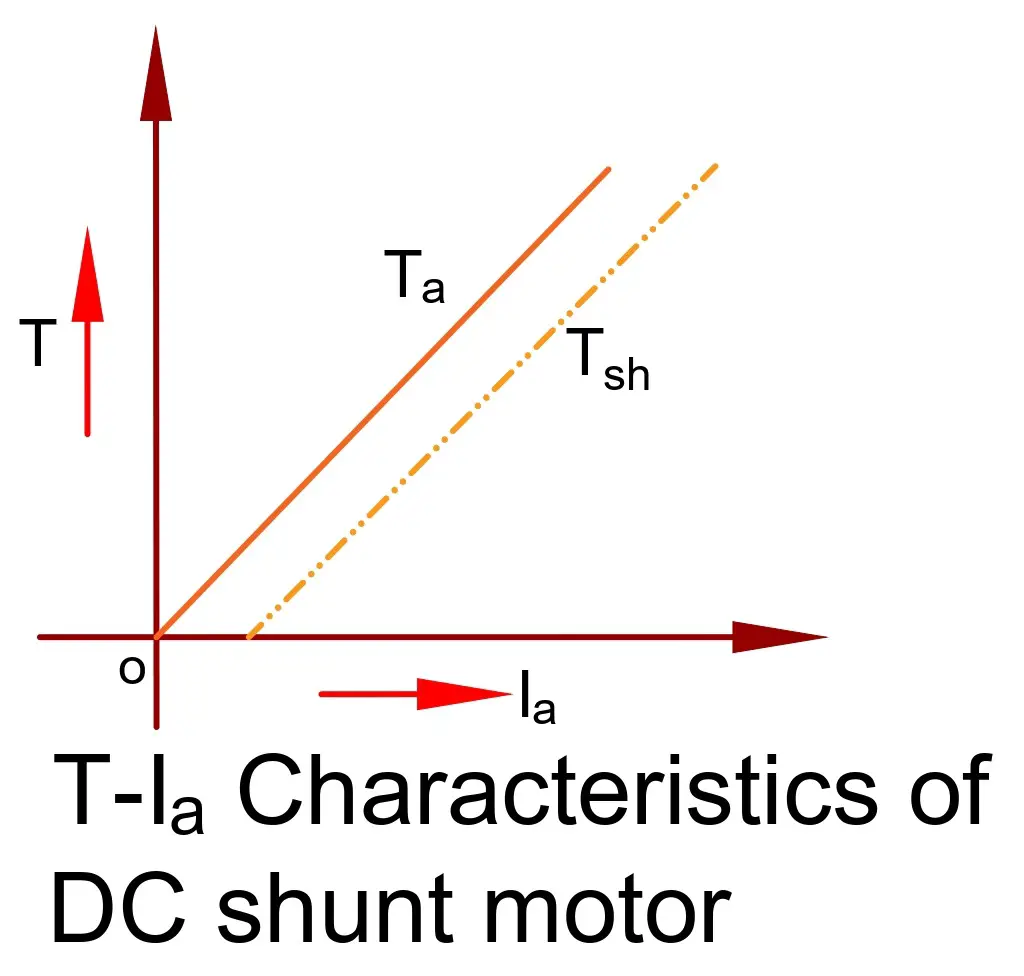The Starting torque is the maximum torque that a motor can deliver to the mechanical load for its rotation. DC motor is capable of delivering high starting torque, and the motor is suitable for driving high inertia loads like a rotary kiln, which demands high starting torque at the time of starting. The DC motor is capable of producing 6 times more torque than its rated torque at the time of starting the motor.
If the load demands higher torque than the maximum torque delivery by the motor, the motor will stall and get overload-tripped. The stall torque is the maximum torque at which the speed of the motor is zero. When the torque demanded by the load is more than the maximum torque delivering capacity, the speed of the motor will become zero, or we can say the motor is incapable of rotating the mechanical load.
Torque Equation of DC Motor
The torque of the DC motor depends on the field flux and magnitude of the armature current.
T=K*Φ*Ia
Where
T= Torque,
Φ=Flux,
Ia= Armature current
In a separately excited motor, the flux is constant, so the torque of the DC motor depends on the armature current. The armature current of the DC motor is very high when the motor starts. The separately excited DC motor circuit diagram is given below.

The back emf induced in the armature can be expressed as ;
Eb=V-Ia*Ra
Ia=(V-Eb)/Ra
When DC voltage is applied to the armature, the back EMF induced in the armature is zero, and the motor draws a very high current.
The back EMF produced in the DC motor depends on the speed of the motor and the field flux. The back EMF of the DC motor can be expressed by following the mathematical formula.
Eb=ΦNZ/60 *(P/A) ——(1)
Where,
Eb= Back EMF induced in the armature
Φ =Main field Flux(Wb/m2)
N = Speed of the motor(RPM)
The torque produced by the DC motor is expressed by the following mathematical expression.
T=K* ΦIa ———(2)
At the start, the back EMF is absent; as a result, the armature current is 5 to 6 times the motor-rated full load current. Therefore, the starting torque of the motor is very high. That is why the armature voltage is increased gradually so that the armature current can be limited to its safe operating range.
The starting torque of the separately excited DC motor and shunt DC motor is less than the starting torque of the DC series motor. However, the separately excited DC motor and shunt DC motor are best suited for the application where speed regulation is required.
Starting torque of DC Series motor
The starting torque of the series DC motor is higher than the starting torque of the separately excited DC motor. The motor is used for the traction system.

In the DC series motor, the field winding is connected in series with the armature winding. As the armature current flows through the field winding, the flux produced in the motor is very high.
T=K*ø*Ia
ø=K*Ia
T=K*I2a

Why DC series motor produce high starting torque?
The torque of the DC series motor is proportional to the square of the armature current. That is why the DC series motor has high starting torque. The DC series motor produces the highest torque among all kinds of motors. The DC series motor produces high starting torque as compared to the separately excited DC shunt motor and the DC shunt motor.
The DC series motor is used for driving high inertia loads, which demand higher starting torque. Examples of high-starting torque applications are rotary kilns, bucket elevators, railway traction, etc. The DC series motor is the best motor for high starting torque and driving high inertia loads. That is why the DC series motor is used to drive heavy loads.
Contrary to the DC series motor, the starting torque of the DC shunt motor increases linearly with the armature current.

The DC motor can deliver the highest torque among all types of DC motors; however, the speed regulation of the DC series motor is poor. In the application where speed regulation is required, the DC shunt motor or separately excited DC shunt motor is preferred.
One more thing about the DC series motor is that it should never be started at no load. The motor can attain an enormously high speed if run on no load. The field current is less when the motor is operated at no load. The speed detection system can be used to detect the over-speed of the motor, and the over-speed detection signal can be used to trip the DC drive.
Starting Torque of DC Shunt motor

The DC shunt motor has field and armature winding. The field winding is connected in parallel to the armature winding. That is why the motor is called a DC shunt motor. The voltage across both windings is the same.
The connection of the field and armature winding is shown below.

The DC shunt motor is best suited for applications where speed regulation is required. The starting torque of the DC shunt motor is less compared to the starting torque of the DC series motor. The flux in the motor remains constant, and the motor delivers the constant torque.
The torque of the DC Motor is proportional to the field flux and the armature current. In the DC shunt motor, the flux is constant; therefore, the torque is proportional to the armature current.
T=K* ΦIa
T=K* Ia (Φ- Constant)
The armature current and torque graph of the DC shunt motor is given below.

Read Next: